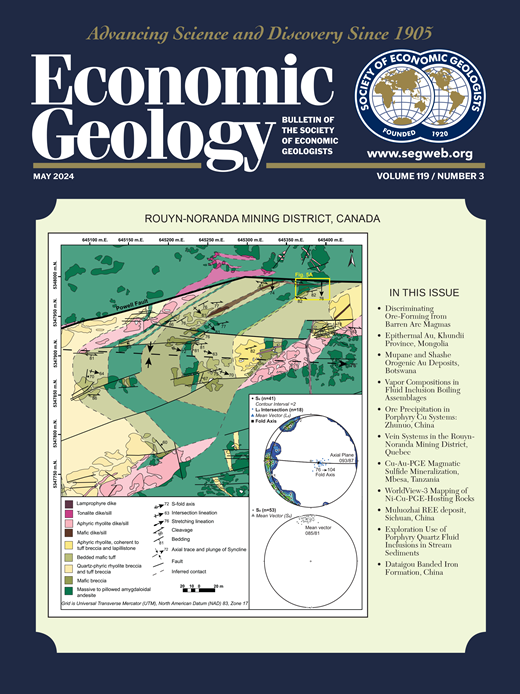厄瓜多尔西科迪勒拉地区Tres Cerrillos远景区构造-岩浆旋回肥力评价
IF 4.9
1区 地球科学
Q1 GEOCHEMISTRY & GEOPHYSICS
引用次数: 0
摘要
本文探讨了厄瓜多尔西部科迪勒拉中新世-上新世岩浆的成矿潜力和岩浆控制作用,评价了特雷斯塞里洛斯远景区与多斑岩铜系统相关的岩浆的时间演化和岩石成因。该区在~11、~10.6、~8.7、~2.7 Ma发育了中中新世至上新世4个明显的岩浆旋回。岩石学、地球化学和年代学数据显示,在每个旋回中,地球化学肥力指标(Sr/Y、V/Sc、La/Yb、Dy/Yb、Zr/Y和(EuN/Eu*)/YbN)均呈上升趋势,从贫瘠向肥沃转变。这些丰富的岩浆特征与下地壳高压和高水条件下的岩浆演化有关,导致角闪洞和石榴石分馏。稀土元素同化-分级结晶模拟表明,在特雷斯塞里洛斯岩浆演化过程中,海洋帕拉坦加基底受到了高度同化作用。所有岩浆旋回的持续时间为~0.5 Ma;然而,根据继承的锆石和40Ar/39Ar的地质年代学,生育指标可能会有更长的上升周期,这表明Cielito和El Pantanal目标是Tres Cerrillos最有前景的目标。生育指标的长期上升被认为是超大型斑岩铜矿的标志。挖掘阶段(~ 15-13、~ 10-9和~ 6-5 Ma)与厄瓜多尔岩浆旋回开始前的压缩期有关。这些挤压相可能有利于岩浆在地壳深处的储存和分异,然后岩浆在更中性的应力条件下转移到地壳上层储层。厄瓜多尔大陆边缘下地形不规则的卡耐基山脊的斜向俯冲可能调节了从挤压构造应力到更中性构造应力的转变,这突出了俯冲动力学在斑岩铜矿形成中的重要性。本文章由计算机程序翻译,如有差异,请以英文原文为准。
Fertility Assessment of Tectono-Magmatic Cycles in the Tres Cerrillos Prospect (Western Cordillera of Ecuador)
This study explores the mineralizing potential and the magmatic controls of Miocene-Pliocene magmas in the Western Cordillera of Ecuador, evaluating the temporal evolution and petrogenesis of magmas associated with multiple porphyry Cu systems at the Tres Cerrillos prospect. Within the prospect, four distinct magmatic cycles at ~11, ~10.6, ~8.7, and ~2.7 Ma were identified, spanning the mid-Miocene to Pliocene. Petrographic, geochemical, and geochronological data reveal a transition from barren to fertile behavior within each cycle, marked by ramp-ups in key geochemical fertility proxies (Sr/Y, V/Sc, La/Yb, Dy/Yb, Zr/Y, and (EuN/Eu*)/YbN). These fertile magmatic signatures are associated with magmas evolving at high-pressure and high-H2O conditions in the lower crust, leading to amphibole and garnet fractionation. Assimilation-fractional crystallization modeling of rare-earth elements indicates a high degree of assimilation of the oceanic Pallatanga basement during the evolution of the Tres Cerrillos magmas. All magmatic cycles have a duration of ~0.5 Ma; however, potentially longer ramp-up periods in fertility proxies, evidenced by inherited zircons and 40Ar/39Ar geochronology, place the Cielito and El Pantanal targets as the most prospective at Tres Cerrillos. A long-lived ramp-up of fertility indicators is considered a hallmark of supergiant porphyry copper deposits. Exhumation phases (~15–13, ~10–9, and ~6–5 Ma) related to periods of increased compression in Ecuador precede the onset of the magmatic cycles. These compressional phases could have favored magma storage and differentiation at deep crustal levels before magmas were transferred to upper crustal reservoirs under more neutral stress conditions. The transition from a compressional to a more neutral tectonic stress regime could have been modulated by the oblique subduction of the topographically irregular Carnegie Ridge beneath the Ecuadorian continental margin, which highlights the importance of subduction dynamics in the formation of porphyry copper deposits.
求助全文
通过发布文献求助,成功后即可免费获取论文全文。
去求助
来源期刊

Economic Geology
地学-地球化学与地球物理
CiteScore
10.00
自引率
6.90%
发文量
120
审稿时长
6 months
期刊介绍:
The journal, now published semi-quarterly, was first published in 1905 by the Economic Geology Publishing Company (PUBCO), a not-for-profit company established for the purpose of publishing a periodical devoted to economic geology. On the founding of SEG in 1920, a cooperative arrangement between PUBCO and SEG made the journal the official organ of the Society, and PUBCO agreed to carry the Society''s name on the front cover under the heading "Bulletin of the Society of Economic Geologists". PUBCO and SEG continued to operate as cooperating but separate entities until 2001, when the Board of Directors of PUBCO and the Council of SEG, by unanimous consent, approved a formal agreement of merger. The former activities of the PUBCO Board of Directors are now carried out by a Publications Board, a new self-governing unit within SEG.
 求助内容:
求助内容: 应助结果提醒方式:
应助结果提醒方式:


